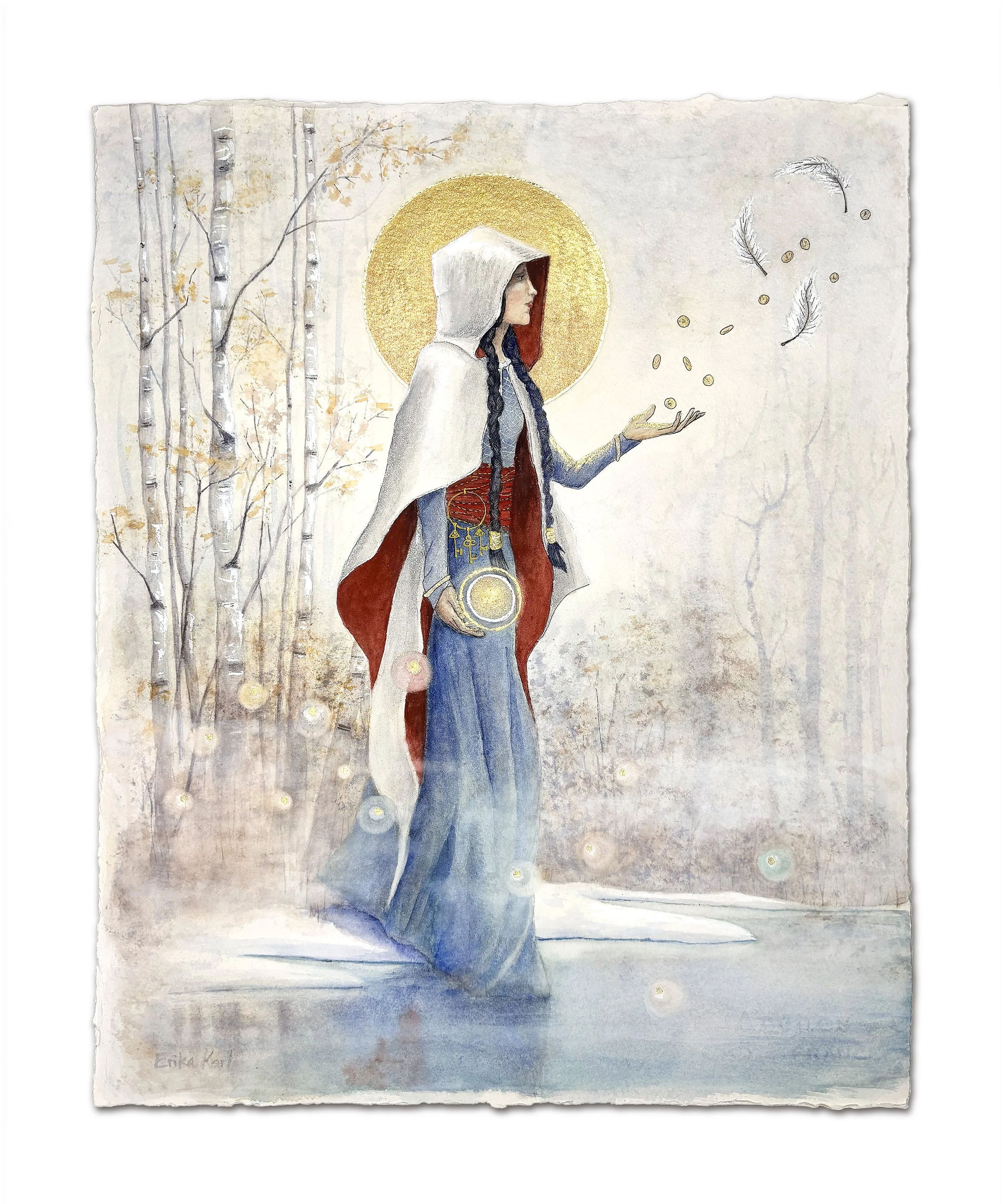Berchta & Frau Perchta: Two Faces of an Alpine Goddess
When winter settles over the land and the days grow short, an ancient presence stirs from the folklore of Germanic peoples. She is known by many names, such as Berchta, Frau Perchta, and the White Lady, and her story reveals how the sacred feminine transforms under the weight of morphing belief systems.
Berchta’s Gift - watercolor on cotton paper by Erika Karl
Berchta: The White Lady of Winter
In her original form, Berchta was a revered goddess who embodied the mysteries of winter. As a psychopomp, she guided the souls of children who died in infancy across the threshold between worlds, offering them safe passage to the afterlife. This motherly role speaks to her connection with life's most vulnerable transitions.
But Berchta was also a goddess of order and diligence. She would reward those who prepared for the harsher season and completed their spinning tasks before winter by leaving gold coins. She exists in the liminal space between seasons, encouraging human effort to meet the unwavering forces of nature. The three keys hanging from her belt symbolized her power over birth, death, and rebirth… the eternal cycle that governed both nature and human life.
The White Lady could also shape-shift into a goose-like form, possibly as a reference to winter preparation... geese fly south for the winter. Geese also only migrate at night, as it’s dangerous to be on the ground at risk of becoming a meal for nighttime predators. I can envision the sounds of geese in the skies at night sounding quite alarming, like a slew of Perchten...
In early Germanic tradition, Berchta sometimes led the Wild Hunt, commanding a host of ominous spirits called the Perchten through winter skies during the twelve nights between Christmas and Epiphany. The Wild Hunt in many cultures has been described as a terrifying racket of spirits and creatures flying down from a winter’s night sky who scoop up any unfortunate soul who fails to look away.
Frau Perchta’s Warning - watercolor on cotton paper by Erika Karl
From Goddess to Witch
As Christianity spread throughout the world, Berchta’s glowing image began to tarnish. The motherly goddess who brought rewards and encouragement became the crone Frau Perchta, a witch-like figure used to scare children and adults alike to reinforce a new set of rules.
This cruel version of Berchta still retained parts of The White Lady, such as the deformed goose foot that hinted towards her shape-shifting abilities. But it painted her as a monster rather than a divine entity. The goddess who rewarded due diligence became a punisher of the lazy, carrying a knife so she could slit open bellies and stuff them full of straw and stone.
This gentle psychopom guiding infant souls is now a sinister spinster haunting nighttime paths as a cruel punisher. The replacement of cherished deities by evil entities became a common occurrence in European folklore. Their magnificent rolls were replaced by witches and monsters, and their divine powers, once worshipped, became something to fear.
Mirrored in Fairy Tales
The influence of Berchta and Frau Perchta is evident in the fairy tales collected by the Brothers Grimm. Mother Goose, with her ties to the White Lady's goose-like form. Little Red Riding Hood skipped through dangerous woods where a wolf, or Frau Perchta, followed her home. A witch who lures children to a candy house and then eats them. Rumpelstiltskin's spinning wheel is a nod to Frau Perchta’s obsession with finishing chores on time. These stories are hints of the old goddess, threads of her lore knit into the fabled tales for a new era. Interestingly, these are now tales told to children, who were the very souls Berchta set out to protect and guide.
Two Paintings, One Goddess
In creating this diptych, I wanted to honor both aspects of this complex figure—not as separate entities, but as two expressions of the same powerful feminine force. Berchta's Gift celebrates the grace and generosity of the goddess in her original matriarchal form. Frau Perchta's Warning acknowledges the shadow cast over her, forever the wicked witch in modern fairy tales. I could only wish a crone would regain her wise-woman status in today’s society.
Together, these two sides of the same coin remind us that transformation doesn't erase what came before. Beneath the surface of fear and folklore, the ancient goddess remains—her dual legacy illustrating how the sacred feminine is both preserved and altered by evolving tradition, and inviting us to see beneath the shadows cast by new beliefs.


